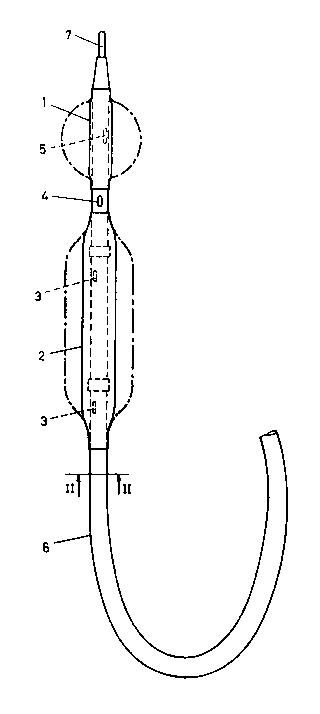Une partie des informations de ce site Web a été fournie par des sources externes. Le gouvernement du Canada n'assume aucune responsabilité concernant la précision, l'actualité ou la fiabilité des informations fournies par les sources externes. Les utilisateurs qui désirent employer cette information devraient consulter directement la source des informations. Le contenu fourni par les sources externes n'est pas assujetti aux exigences sur les langues officielles, la protection des renseignements personnels et l'accessibilité.
L'apparition de différences dans le texte et l'image des Revendications et de l'Abrégé dépend du moment auquel le document est publié. Les textes des Revendications et de l'Abrégé sont affichés :
| (12) Brevet: | (11) CA 1326426 |
|---|---|
| (21) Numéro de la demande: | 1326426 |
| (54) Titre français: | CATHETER DE DILATATION PERMETTANT DE CORRIGER LE RETRECISSEMENT DE L'ARTERE CAROTIDE |
| (54) Titre anglais: | DILATATION CATHETER FOR THE CAROTID ARTERY |
| Statut: | Périmé et au-delà du délai pour l’annulation |
| (51) Classification internationale des brevets (CIB): |
|
|---|---|
| (72) Inventeurs : |
|
| (73) Titulaires : |
|
| (71) Demandeurs : |
|
| (74) Agent: | SMART & BIGGAR LP |
| (74) Co-agent: | |
| (45) Délivré: | 1994-01-25 |
| (22) Date de dépôt: | 1989-09-25 |
| Licence disponible: | S.O. |
| Cédé au domaine public: | S.O. |
| (25) Langue des documents déposés: | Anglais |
| Traité de coopération en matière de brevets (PCT): | Non |
|---|
| (30) Données de priorité de la demande: | ||||||
|---|---|---|---|---|---|---|
|
DILATATION CATHETER FOR WIDENING OF STRICTURES
Abstract
A dilatation catheter intended in particular for
treatment of strictures in the carotid artery has at
its front end a dilatation balloon, which is inserted
in the folded state into the carotid artery and is
inflated in order to widen the stricture. In front of
the dilatation balloon a sealing balloon is arranged
which serves to seal off the carotid artery downstream
of the stricture, in order thereby to prevent a
migration of any stricture material which may become
detached during treatment, and thus to avoid the risk
of an embolism. Between the dilatation balloon and the
sealing balloon there is a draw-off and inlet opening
through which, after widening and with the sealing
balloon inflated, detached stricture material can be
drawn off or washed away.
Note : Les revendications sont présentées dans la langue officielle dans laquelle elles ont été soumises.
Note : Les descriptions sont présentées dans la langue officielle dans laquelle elles ont été soumises.

2024-08-01 : Dans le cadre de la transition vers les Brevets de nouvelle génération (BNG), la base de données sur les brevets canadiens (BDBC) contient désormais un Historique d'événement plus détaillé, qui reproduit le Journal des événements de notre nouvelle solution interne.
Veuillez noter que les événements débutant par « Inactive : » se réfèrent à des événements qui ne sont plus utilisés dans notre nouvelle solution interne.
Pour une meilleure compréhension de l'état de la demande ou brevet qui figure sur cette page, la rubrique Mise en garde , et les descriptions de Brevet , Historique d'événement , Taxes périodiques et Historique des paiements devraient être consultées.
| Description | Date |
|---|---|
| Inactive : CIB expirée | 2013-01-01 |
| Le délai pour l'annulation est expiré | 2009-01-26 |
| Lettre envoyée | 2008-01-25 |
| Inactive : CIB de MCD | 2006-03-11 |
| Inactive : CIB de MCD | 2006-03-11 |
| Accordé par délivrance | 1994-01-25 |
Il n'y a pas d'historique d'abandonnement
| Type de taxes | Anniversaire | Échéance | Date payée |
|---|---|---|---|
| TM (catégorie 1, 4e anniv.) - générale | 1998-01-26 | 1997-11-05 | |
| TM (catégorie 1, 5e anniv.) - générale | 1999-01-25 | 1999-01-13 | |
| TM (catégorie 1, 6e anniv.) - générale | 2000-01-25 | 2000-01-11 | |
| TM (catégorie 1, 7e anniv.) - générale | 2001-01-25 | 2000-12-19 | |
| TM (catégorie 1, 8e anniv.) - générale | 2002-01-25 | 2001-12-19 | |
| TM (catégorie 1, 9e anniv.) - générale | 2003-01-27 | 2002-12-17 | |
| TM (catégorie 1, 10e anniv.) - générale | 2004-01-26 | 2003-12-16 | |
| TM (catégorie 1, 11e anniv.) - générale | 2005-01-25 | 2004-12-16 | |
| TM (catégorie 1, 12e anniv.) - générale | 2006-01-25 | 2005-12-14 | |
| TM (catégorie 1, 13e anniv.) - générale | 2007-01-25 | 2006-12-15 |
Les titulaires actuels et antérieures au dossier sont affichés en ordre alphabétique.
| Titulaires actuels au dossier |
|---|
| SCHNEIDER (EUROPE) AG |
| Titulaires antérieures au dossier |
|---|
| RAMAZAN ALI AHMADI |